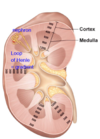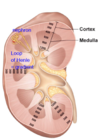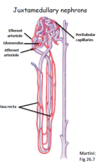Renal 3/4: Micturition and The kidney’s in homeostasis Flashcards
(98 cards)
Urine composition is very different to filtrate. What are the 3 differences?
- Important molecules are reabsorbed (eg. Glucose, amino acids)
- Waste products are concentrated (eg. Urea, drugs)
- Ions & water vary depending on blood concentration

How is filtrate different to plasma?
filtrate is like plasma but without proteins
What is the function of ureters?
Transports urine to bladder

What are the 2 functions of the bladder?
- Storage of urine
- Stretches to accommodate urine, contracts during voiding

What are the 2 functions of the urethra?
- Transports urine to exterior
- Transit of urine is controlled by sphincters

Micturition involves the relaxation of two _____.
sphincters
What are the 2 sphincters in charge of micturition?
- Internal urethral
- External urethral

What are the 3 characteristics of the internal urethral sphincter?
- Smooth muscle
- Involuntary
- Part of the bladder wall

The internal urethral sphincter is made of _____ muscle
Smooth muscle

The internal urethral sphincter is ____ (voluntary/involuntary).
involuntary

What are the 2 characteristics of the external urethral sphincter?
- Skeletal muscle
- Voluntary

The external urethral sphincter is made of _____ muscle
skeletal

The external urethral sphincter is ____ voluntary/involuntary.
voluntary

The micturition reflex is _____ (voluntary/involuntary) and controlled at the _____.
involuntary; spinal cord

Filling of the bladder stimulates ____ receptors
stretch

Stretch receptors trigger ____ stimulation of the bladder muscle (contraction), which results in the opening of the ____ urethral sphincter.
parasympathetic; internal

What is the process of the micturition reflex?

Micturition reflex inhibits motor neurons innervating the ____ urethral sphincter
external

Micturition is is involuntary- but have voluntary control over it (by controlling ___ sphincter)
external

Micturition occurs when there is _____ (opening/closing) of both urethral sphincters?
opening

Voluntary signals from cerebral cortex over-rides inhibition of motor neurons. What does that mean for the external sphincter?
can override opening of external sphincter (relax) = exhibition = contract = closed (done by sending AP)

The kidneys help to maintain _________ in the body by controlling the composition of the ECF
homeostasis

What are 5 inputs into the kidney? How is it produced?
- Ingestion
- Inhalation
- Absorption through body surfaces
- Injection
- Produced through metabolism
What are 4 outputs into the kidney? How are they consumed?
- Kidneys
- Lungs
- Digestive tract
- Body surface (sweat, tears)
- Consumed through metabolism


























































